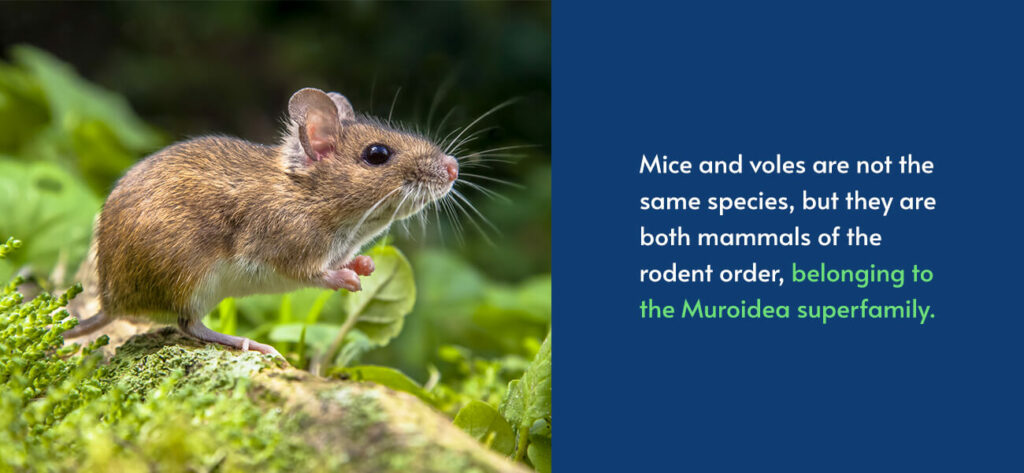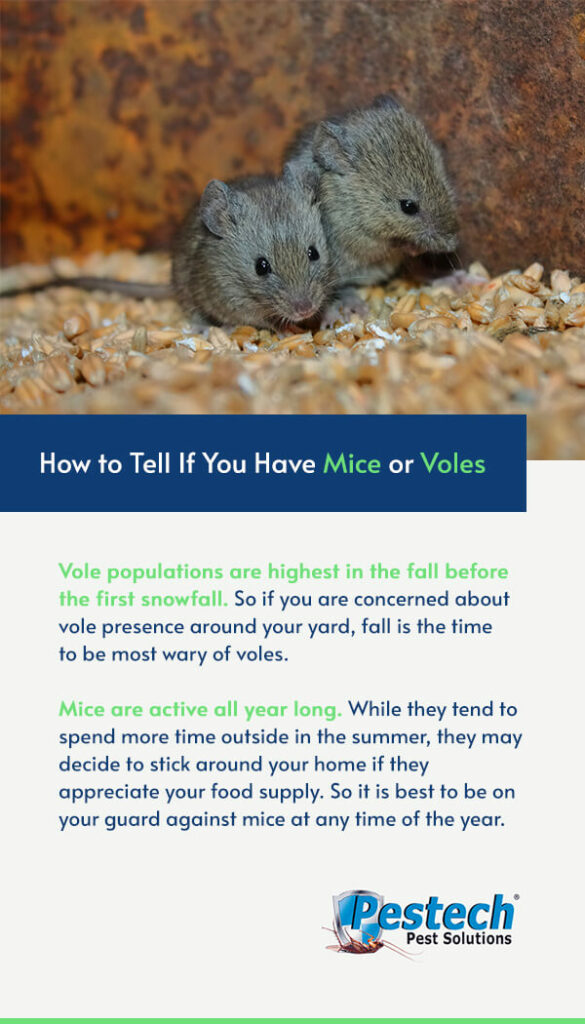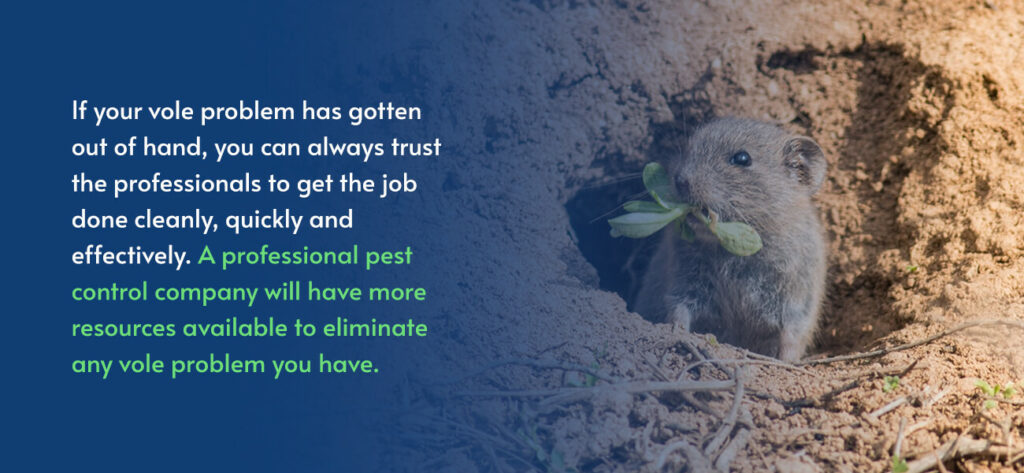Vole vs. Mouse: What’s the Difference?

Some people find voles and mice adorable. They scurry around with tiny paws, little whiskers, cartoonish ears and innocent-looking faces. Yet, that innocence vanishes once they start causing problems in your home, lawn or garden.
Voles and mice share several other similarities, leading many people to confuse voles and mice with each other. Though knowing the difference between these rodents may seem unnecessary, it is essential for dealing with infestations.
As mice and voles have different appetites, habitats and behaviors, they also respond differently to control measures. Thus, knowing those differences can help you respond to an infestation effectively. Learn more about the differences and similarities between mice and voles.

Are Mice and Voles the Same Species?
Mice and voles are not the same species, but they are both mammals of the rodent order, belonging to the Muroidea superfamily. However, that is as far as their taxonomic similarities go. Voles belong to the Arvicolinae subfamily, along with muskrats and lemmings. In contrast, mice belong to the Murinae subfamily and are relatives of rats and gerbils.
Furthermore, there are also various mice and vole species. Under the genus Mus, for mice, there are 38 species. Except for the common house mouse, most mice species in the United States belong to different genera. There are approximately 60 species under the genus Microtus for voles. The most common vole species in the Northeastern U.S. are:
- The meadow vole, or Microtus pennsylvanicus, otherwise known as a field mouse
- The red-backed vole, or Clethrionomys gapperi
- The rock vole, or Microtus chrotorrhinus
- The pine vole, or Microtus pinetorum, also called a woodland vole
Of those vole species, home and property owners most commonly encounter the meadow vole and pine vole. Red-backed and rock voles primarily live in mountainous regions.
As for mice, the most common species in the Northeastern U.S. are:
- The deer mouse, or Peromyscus maniculatus
- The white-footed mouse, or Peromyscus leucopus
- The meadow jumping mouse, or Zapus hudsonius
- The woodland jumping mouse, or Napaeozapus insignis
- The house mouse, or Mus musculus
The Similarities Between Mice and Voles
As mentioned, mice and voles are both small, furry rodents. Those characteristics are enough for most people to confuse them! Besides being small and furry, mice and voles also share the following characteristics:
- They both have round ears.
- They are usually between 5 to 8 inches long, tail included.
- They usually have gray or brown fur.
- Mice and voles are both active year-round, except for meadow and woodland jumping mice, which hibernate during the winter.
- Most vole and mice species are nocturnal.
- Their teeth are optimized for gnawing.
- Both mice and voles cache food in storage chambers for the winter when supplies are less abundant.
How Mice and Voles Differ From Each Other
Despite basic similarities, mice and voles differ in many ways from each other. While each vole and mice species has unique characteristics, general differences between mice and voles also exist. Three avenues to identifying voles and mice are appearance, appetite and habitat.
Appearance
In general, voles have:
- A stout body.
- Short and hairy tail.
- Short legs.
- Small eyes and ears.
- A blunt nose.
- A round head.
Although voles and mice are relatively similar in size, voles appear rounder and fuller-bodied. They also weigh twice as much as house mice and lack the characteristic pink, hairless tail of house mice. Their round head, beady eyes and tiny ears are more typical of a hamster than a mouse.
In contrast, mice generally have:
- A slender body.
- A long, scaly and hairless tail.
- A pointy nose and head.
- Larger eyes and ears.
- Relatively long legs.
With larger eyes, mice have superior night vision abilities. Mice tails are 1 to 2 inches longer than vole tails, on average. Overall, the best way to distinguish between mice and voles is by examining their tail length. Vole tails range from 1 to 2 inches long, while mouse tails range from 2.5 to 6 inches long, depending on the species.
Here are some ways the appearances of common mice and vole species in the Northeastern U.S. differ from each other:
- Meadow voles: The meadow vole or field mouse has a dull, chestnut brown coat with a darker area lining their spines. They also have grayish-white underparts. Their tails range from 1.3 to 2.5 inches long.
- Rock voles: These rodents have a similar coat and tail length to meadow voles, except they also have yellowish-orange noses.
- Woodland voles: These voles have a soft, glossy chestnut brown coat with gray undersides. Their tails range from a half-inch to 1 inch long.
- Southern red-backed voles: The southern red-backed vole has a reddish stripe down its back and a pale grey belly. Their tails are 1.5 to 2 inches long.
- Deer mice: These mice have a grey coat for their first month and then molt into a brownish-grey coat with a white undersurface. Their tails are approximately 3 to 4 inches long.
- White-footed mice: The white-footed mouse has a reddish-brown coat with a white belly and feet. Their tails are between 2.5 to 3.5 inches long.
- House mice: The common house mouse has a grey coat of varying shades. Their tails are approximately 3 inches long.
- Woodland jumping mice: These rodents have a bright yellowish-brown coat and a white belly. A white tuft tips the end of their tail, which is around 5.5 inches long.
- Meadow jumping mice: These mice have yellowish-brown fur with a dark stripe down the middle of their back and orangish sides. Their bellies and feet are white. Meadow jumping mice tails range from 5 to 6 inches long.
Appetite
One of the best ways of identifying mice or voles is by what they eat. Voles are mainly herbivores, while mice are omnivores. While voles stick to fruits, plants, grains and seeds, mice will eat almost anything. A typical vole diet involves the following foods:
- Roots
- Stems
- Leaves
- Seeds
- Fruits
- Tree bark
- Potatoes
- Flower bulbs
- Grasses
- Sedges
- Tubers
- Grains
- Fungi
While mice are omnivores, they prefer grains, fruits, seeds and anything high in carbohydrates. However, they will eat anything they find if they are hungry enough. Other food sources that mice eat include:
- Soybeans
- Berries
- Buds
- Nuts
- Mushrooms
- Beetles
- Grasshoppers and crickets
- Caterpillars
- Earthworms
- Centipedes and millipedes
- Slugs
- Spiders
- Small birds
- Other mice
- Fungi
- Roots
- Paper
- Glue
- Household soap
- Pet food
Habitat
As omnivores, mice thrive anywhere with food and shelter — inside your walls or in a wooded meadow. In the wild, mice live in:
- Cultivated fields
- Farm buildings
- Fencerows
- Pastures
- Ravines
- Rhododendron thickets
- Shrubby areas
- Stream margins
- Woods
Mouse nests vary slightly with each species. Deer mice often make their nests at ground level in hollow logs, stumps, fence posts and underground channels or beneath rocks. They also establish nearby latrines for waste and chambers for storing food. In contrast, white-footed mice nest in stone walls, rock crevices, tree cavities and abandoned bird or squirrel nests.
Voles prefer to stay close to food sources. They don’t eat glue or soap, so they have less reason to stay indoors than mice. They also cannot reproduce indoors. If you find them indoors, they aren’t likely to stick around for long. However, they may linger if they discover enough food supply around your property. You may find them occasionally wandering indoors if they do.
Voles typically burrow 3 to 4 inches underground and establish surface runways through lawns, snow and grassy pastures. They prefer to travel under snow or grassy cover to hide from predators.

How to Tell If You Have Mice or Voles
Vole populations are highest in the fall before the first snowfall. So if you are concerned about vole presence around your yard, fall is the time to be most wary of voles.
Here are some signs that you may have voles:
- Discovering dead woody plants at the beginning of spring
- Damaged, beaten down grass in lines across your lawn that are 2 inches wide
- Various burrow openings and small, conical piles of soil along runways
- Bits of vegetation and vole feces along runways.
- Gnawed rings around small trees, approximately 1/8-inch wide, 3/8-inch long and 1/16-inch deep
Mice are active all year long. While they tend to spend more time outside in the summer, they may decide to stick around your home if they appreciate your food supply. So it is best to be on your guard against mice at any time of the year. Signs you have mice living on your property include:
- Strong mousy, ammonia-like odors inside your house.
- Grease marks on walls, floors and floorboards from mice brushing against those surfaces.
- Mice droppings inside or on top of cupboards or along floorboards.
- Scratching sounds in the walls, ceiling, basement, lofts or floorboards.
- Papery nests in attics, suspended ceilings and wall cavities; behind fridges; or under stoves, cabinets and floorboards.
- Tracks or footprints on dusty surfaces.
- Seeing a live or dead mouse during the daytime.
- Holes or gnaw marks in food packages.
Problems Caused by Mice and Voles
Voles are less likely to cause damage to your home or building than mice. They prefer to chew on softer vegetation, while mice will gnaw on anything. Thus, voles typically cause problems in gardens and lawns, while mice can cause significant structural damage. Since mice enjoy the indoors more than voles, they are also more likely to contaminate food supplies and other household materials with urine and feces.
Some specific problems caused by mice that home and property owners often encounter include:
- Eating food from your pantry.
- Contaminating food or surfaces with waste.
- Causing damage to wooden structures from gnawing.
- Increasing the risk of various diseases from urine or feces, including Lyme disease, hantavirus and food poisoning bacteria.
- Increasing allergic reactions from household members or visitors.
- Chewing wire insulation.
- Building nests in large electrical appliances, creating fire hazards.
Since buildings protect mice from predators, they quickly multiply when they establish nests in or near homes. Effective elimination of an established mice colony often requires professional pest control services.
As for voles, some common problems they may cause around your property include:
- Digging burrows or creating pathways of dead grass, called runways, on your lawn.
- Eating plants, fruits or vegetables in your garden or orchard
- Girdling small trees, or eating tree bark rings around small trees in your yard or nursery.
How to Take Care of a Mouse Problem
Taking care of a mouse problem is often a joint effort between homeowners and pest control professionals. A pest control company can eliminate a mouse problem once it occurs. However, you can do several things to prevent them from happening and make habitation undesirable for mice, including these tips:
- Find their entryways and block them. Look for small and well-worn trails near your house, smudge marks along the sides of your home and gaps or holes around utility lines.
- Keep floors and surfaces free from crumbs and spills.
- Clean behind the fridge and stove and other large appliances.
- Keep an eye out for and dispose of mouse droppings properly.
- Frequently dispose of garbage and remove recycling from your property.
- Use snap-back mouse traps with oatmeal, peanut butter, cheese, sunflower seed or cotton balls as bait.

How to Take Care of a Vole Problem
If your vole problem has gotten out of hand, you can always trust the professionals to get the job done cleanly, quickly and effectively. A professional pest control company will have more resources available to eliminate any vole problem you have. Still, you can take steps to prevent vole infestations or minimize their presence. Here are some things you can do to take care of a vole problem:
- Mow your lawn regularly.
- Pick up fallen fruits and vegetables in your garden.
- Limit vegetation against structures.
- Clean up piles of leaves and branches in your yards.
- Remove grass and weeds around trees and shrubs.
- Keep the first few inches of ground surrounding plant bark as bare soil.
- Limit mulching in flower beds.
- Install fine-gauge hardware cloth around tree trunks before it snows.
- Mow your lawn slightly lower than usual at the end of fall to deter voles from making runways.
- Use snap-back mouse traps in boxes with holes on either side. Place apple slices or peanut butter-oatmeal mixtures on the traps as bait.
Call Pestech Today to Deal With Mice and Voles
Whether you have mice or voles or both living in or around your property, Pestech’s pest control professionals can help! Our family-owned and -operated company has provided pest control services to commercial and residential properties throughout New York for over 30 years. We’ve handled numerous pest species throughout that time with unbeatable customer service.
If you notice signs of a vole or mice infestation in or around your home, call Pestech today for an inspection! We will set your mind at rest by either ruling out an infestation or responding to one swiftly and effectively. We won’t rest until we successfully solve your pest problem!

